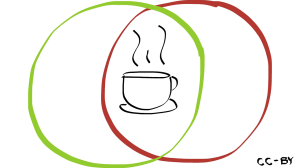A teaching and learning conversation with:
 Andrew Middleton Andrew Middleton
Sheffield Hallam University |
 Kathrine Jensen Kathrine Jensen
University of Huddersfield |
When: Thursday 26th November 12:30-13:30 (60 minutes)
Purpose:
To explore the value of in between spaces for learning and developing a sense of belonging
About this conversation:
In this active webinar we will think about the experience of the learner and the academic in higher education and invite you to consider what inbetween spaces are and how you or your students experience them. Together we will come up with examples of inbetween spaces and discuss their characteristics, benefits and importance to developing a sense of belonging.
We will consider the idea that “The richest space of all is the in between space”
By inbetween spaces we mean spaces that are outside pre-defined boundaries (and where there is the potential for people to step outside/transcend existing roles/identities).
A lecture room or an institutional virtual learning environment are examples of bounded spaces that are well established and where the roles and expected contribution of staff and students are built in. In contrast inbetween spaces are characterised by having less structure and less well defined roles and therefore potentially they are spaces where less formalised interactions and conversations can happen. Inbetween spaces are thus characterised by boundary crossings. The value of inbetween space is found in the example of having a conversation over a cup of coffee in a cafe or the act of favouriting a tweet.
There are many ways of thinking about inbetween spaces and how they are valued. For example, spaces that are not work nor home and sit between notions of public and private spaces have been conceptualised in a number of sometimes overlapping ways: as ‘third space’, ‘third place’ or indeed ‘fourth place’ as well as ‘liminal’ spaces of transition and transformation. The webinar will not cover the extensive literature related to these concepts, however, anyone interested can take a look at the collection of links below.
Links:
A conversation about Third Space, Third Place, and Liminality by Catherine Cronin
https://catherinecronin.wordpress.com/2014/07/24/conversation/
Learning in 3rd Space – a slideshare presentation by Reijo Kupiainen, University Lecturer at University of Tampere. From March 2014 http://www.slideshare.net/rkupiainen/trondheim2014-third-space-kopio
Third Space: Curated Bibliography by Mary Ann Reilly. The bibliography contains links to work by Homi Bhabha, Kris Gutiérrez, Edward Soja, Reijo Kupiainen, and more.
http://maryannreilly.blogspot.ie/2014/07/third-space-curated-bibliography.html
Enhancing teaching and learning through dialogue: a student and staff partnership model Jensen, K. and Bennett, L. (2015). The International Journal of Academic Development, 21 (1). (In Press).
Joining the conversation:
Simply follow this link http://mmu.adobeconnect.com/tlc/ and enter as a guest by typing your name, institution and country into the name field and clicking on the “Join Meeting” button.
Whether or not you have previously participated in a webinar or online activity using Adobe Connect we advise that you make sure that you do some checking and preparation in advance. Check your set-up and connection here.
You may also find our Adobe Connect Webinar Participant Guide useful to print out in advance of the session.We really hope that you will be able to join for what should be a lively and highly interactive TLC.


Love the sound of this, Andrew and Kathrine. I have an existing commitment at 1pm on the 26th (drat!) but will tune in for the start of the session, at least. Moving beyond the stale binaries of open/closed, institutional/personal, formal/informal is a fruitful way of thinking about our, and our students’, learning practices and interactions. Looking forward to your session very much 🙂
LikeLike
Pingback: Inbetween Spaces for Learning | Caroline+Kühn
Hi Catherine, great that you can join us (even if only for part of it). I think it will be really useful to have your ideas and input from your research. When Andrew and I discussed the webinar I described it as a continuation of our conversation(s) and hopefully this will spark even more ideas and connections. Look forward to seeing you there 🙂
LikeLike
Pingback: Exploring in-between spaces | kshjensen – always learning
Pingback: Third Places & Third Spaces - #DigPed PEI | the theoryblog
Pingback: Third Places and Third Spaces: #digped PEI - Digital Pedagogy Lab
Pingback: Finding the open in the in-between: changing culture and space in higher education | Tactile
Pingback: ‘Openish’ and open education as disruptive innovation | Tactile